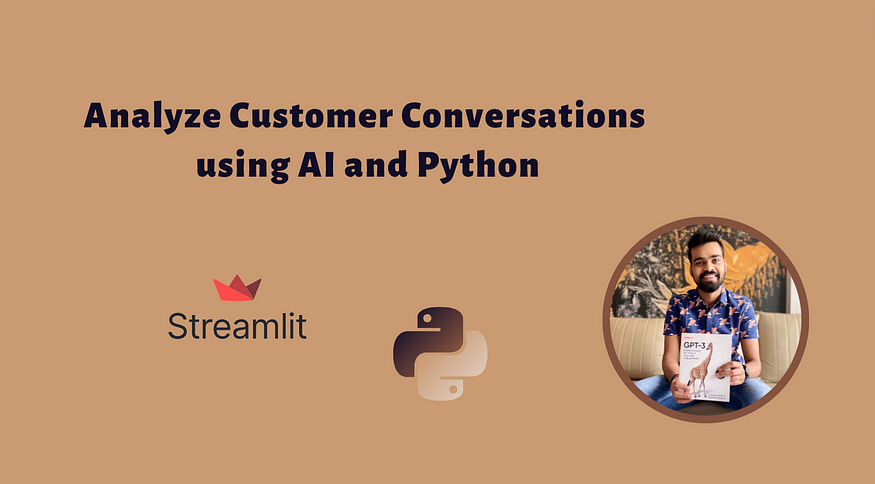
Detect Business Insights From Customer Support Conversations Using AI
Last Updated on July 25, 2023 by Editorial Team
Author(s): Shubham Saboo
Originally published on Towards AI.
Learn how to analyze customer conversations with just 15 lines of Python code!

Background
A positive customer experience can make the difference between losing and retaining customers. Businesses need to constantly improve their products and services and identify trends and issues at an early stage to keep their customers satisfied!
It has become more crucial than ever to analyze customer support data and derive valuable insights to ensure that necessary modifications and enhancements are undertaken early on the basis of the customer
preferences, and the business perform effectively to support the same.
But that’s the biggest challenge. Unfortunately, most businesses struggle to capture and make sense of the data derived here. While it would be cumbersome to listen to all the calls or skim through all the emails to figure out the insights, even sample picking wouldn’t ensure that the problem areas are correctly identified. A few lines of code can help you accelerate your business growth by figuring out what customers really want!
How to make sense of this huge volume of data?
Introducing One AI studio!
One AI is a language AI service where various pre-trained NLP models are packaged and made available through API, enabling language comprehension in context and transforming texts from any source into structured data. One AI studio is capable of performing a wide array of tasks including but not limited to:
- Transcribing audio files
- Generating Highlights of the input
- Topic extraction
- Emotions as well as Sentiments detection
- Identification of Keywords
- Identifying Action Items
- Clustering the data basis skills as parameters like Keywords or Sentiments, etc.

Let’s look at how you can build a streamlit application to analyze customer support conversations using One AI and Python. All you need to have is the following:
- Basic knowledge of Python
- Streamlit
- One AI API
Application Walkthrough
We will use the Streamlit framework to build a beautiful frontend in python itself. Here is a step-by-step walkthrough to building a Python application for analyzing customer support conversations:
- Import the necessary libraries and get the API key from the user.
2. Get the conversation or email trail as input from the user and create functionality to select between different intelligence features.
3. Format the input data to be processed by the language model by converting it into JSON.
4. Set the headers, API endpoint address, and the payload to be sent to the API. Use the request library to hit the API endpoint and get the output returned in JSON format.
5. Process the JSON file and display the output to the end users!
U+1F31F Here is the GitHub repository to get the source code:
GitHub – Shubhamsaboo/customer-centre-analytics-NLP: Use One AI API to analyze the deep customer…
You can't perform that action at this time. You signed in with another tab or window. You signed out in another tab or…
github.com
This is what our final application looks like U+1F447

AI-powered Analytics in Action U+1F579
Now let’s look at how we can use the above application in real-world scenarios:
Step 1: First things first, you have to put your API Key for authentication. Copy your One AI API Key and paste it onto the sidebar.

Paste the API key in the application sidebar.
Step 2: Let’s get the ball rolling. Enter the transcript of an audio call in the input box and select an intelligence feature.
Sample conversation
Ensure that the input is given in the below format.
Customer:Hi, I am Dragos from Leverkin Management. I am having a lot of trouble with using your product, it is very complicated. I require a training session.Agent:Hi, I’m sorry to hear that. I will surely schedule a session for you. Is Tuesday 5 p.m. a good time?Customer:Yes, that will work thanks.
- “Summary” as an intelligence feature:
2. “Named Entity Recognition” as an intelligence feature:
3. “Emotion Detection” as an intelligence feature:
4. “Sentiments Analysis” as an intelligence feature:
5. “Topics Detection” as an intelligence feature:
Try it out yourself U+1F449 Streamlit Application
Conclusion
AI will revolutionize the way customer center data is analyzed. It would play a pivotal role in how useful insights can be derived from customer experience efficiently and with greater accuracy. By identifying customer needs and preferences, call center agents will be able to provide a more personalized and satisfying customer service experience.
If you would like to learn more or want me to write more on this subject, feel free to reach out.
My social links: LinkedInU+007C Twitter U+007C Github

If you liked this post or found it helpful, please take a minute to press the clap button, it increases the post's visibility for other medium users.
Join thousands of data leaders on the AI newsletter. Join over 80,000 subscribers and keep up to date with the latest developments in AI. From research to projects and ideas. If you are building an AI startup, an AI-related product, or a service, we invite you to consider becoming a sponsor.
Published via Towards AI
Take our 90+ lesson From Beginner to Advanced LLM Developer Certification: From choosing a project to deploying a working product this is the most comprehensive and practical LLM course out there!
Towards AI has published Building LLMs for Production—our 470+ page guide to mastering LLMs with practical projects and expert insights!

Discover Your Dream AI Career at Towards AI Jobs
Towards AI has built a jobs board tailored specifically to Machine Learning and Data Science Jobs and Skills. Our software searches for live AI jobs each hour, labels and categorises them and makes them easily searchable. Explore over 40,000 live jobs today with Towards AI Jobs!
Note: Content contains the views of the contributing authors and not Towards AI.














